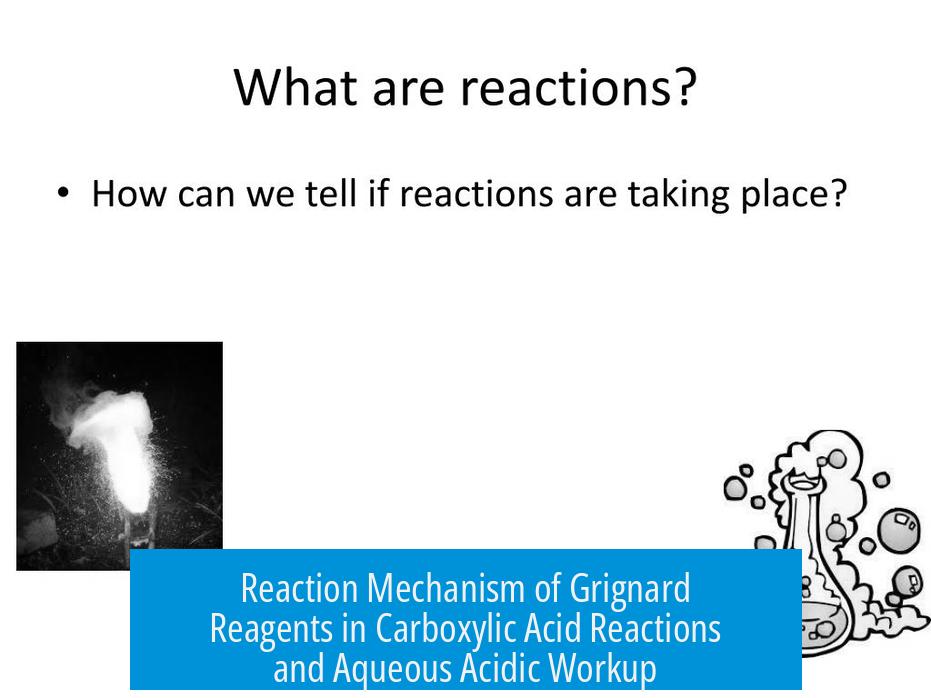Reaction Mechanism of Grignard Reagents
The reaction mechanism of Grignard reagents primarily involves nucleophilic attack on electrophilic centers, but their interaction with carboxylic acids follows a distinct pathway where the initial equivalent gets quenched, and subsequent reactions lead to complex intermediates rather than straightforward ketone formation.
Initial Interaction with Carboxylic Acids
When a Grignard reagent reacts with a carboxylic acid, the first equivalent is consumed by acid-base neutralization. The acidic proton of the carboxylic acid protonates the Grignard reagent, forming a magnesium carboxylate and releasing the corresponding hydrocarbon from the Grignard reagent. This step effectively quenches the first equivalent, preventing it from acting as a nucleophile initially.
Reactivity of Magnesium Carboxylate
Despite this quenching, the magnesium carboxylate intermediate retains a carbonyl group. This carbonyl carbon is less electrophilic than those in aldehydes or ketones due to electron delocalization over the carboxylate anion. However, in the absence of water, the magnesium carboxylate can react with a second equivalent of the Grignard reagent. This step leads to the formation of a dialcoholate species.
Outcome Upon Aqueous Acidic Workup
Subjecting the dialcoholate intermediate to a mild aqueous acidic workup typically results in the formation of a geminal diol. Geminal diols are often unstable and shift the equilibrium toward a dehydrated ketone form. For example, 1-phenyl-2-(propan-2-yl)but-3-en-1-one can be obtained after dehydration. This explains why direct ketone formation is uncommon in these reactions without controlled conditions.
Challenges and Practical Innovations
The classical approach of treating carboxylic acids with Grignard reagents is complicated due to the initial acid-base quenching and poor electrophilicity of the carboxyl carbon. To address this, the Mendoza group developed a practical and scalable protocol. This method involves using bulky turbo-organomagnesium anilides, facilitating the direct addition of Grignard reagents to aliphatic carboxylic acids, improving yield and handling (see Chem. Eur. J., 2021).
Consideration of Acid-Base Properties
pKa values play a crucial role. The acidity of the carboxylic acid vs. the basicity of the Grignard reagent determines the extent of initial quenching. Generally, the highly acidic proton of the carboxyl group neutralizes the Grignard reagent before nucleophilic attack can occur.
Summary
- First equivalent of Grignard reagent is quenched by protonation from carboxylic acid.
- Magnesium carboxylate intermediate can react with a second equivalent of Grignard to form dialcoholate.
- Carboxyl carbon shows weak electrophilicity due to electron delocalization.
- Aqueous acidic workup yields an unstable geminal diol that favors ketone formation via dehydration.
- Modern methods use modified magnesium reagents to enable direct addition to carboxylic acids.
- Acid-base equilibria heavily influence reaction feasibility; pKa values are critical.
What happens to the first equivalent of Grignard reagent when it reacts with a carboxylic acid?
The first equivalent of Grignard reagent is quenched by the carboxylic acid. This step consumes it completely before further reactions can occur.
Can the magnesium carboxylate react with a second equivalent of the Grignard reagent?
Yes, the magnesium carboxylate can react with a second equivalent of Grignard reagent. It forms a dialcoholate because the carbonyl group remains reactive without water present.
Why is the carboxyl carbon less electrophilic than an aldehyde or ketone carbon?
The electron density in the carboxyl group is highly distributed. This lowers its electrophilicity compared to aldehydes or ketones, making it a poor electrophile for nucleophilic attack.
What does the aqueous acidic workup yield after Grignard reacts with the carboxylate?
The workup typically yields a geminal diol. This geminal diol is often unstable and tends to dehydrate, forming a ketone instead of remaining as the diol.
How did the Mendoza group improve Grignard additions to aliphatic carboxylic acids?
They developed a more practical and scalable approach using bulky turbo-organomagnesium anilides. This method allows direct addition of Grignard reagents to carboxylic acids effectively.





Leave a Comment